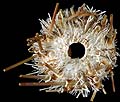|
Diagnostic Features
|
-
Test of moderate size, depressed with uniformly rounded sides.
-
Apical disc large, with large subcircular periproct. Apical disc plating dicyclic. Periproctal membrane covered in small uniform platelets.
-
Ambulacral zones moderately broad and straight; not expanded adorally.
-
Pore-pairs in weakly offset triads. Ambulacral plating compound in triads with all three elements extending to the perradial suture. Large primary tubercle to each compound plate and with a narrow zone of granules perradially at most.
-
Interambulacral plates a little wider than tall; dominated by large primary tubercle with a large areole and small mamelon. All tubercles perforate and non-crenulate. Rest of plate covered with heterogeneous granulation, including small interradial secondary tubercles.
-
Spines long and slender, without cortex; primary spines solid with medulla in cross-section; secondary spines with a hollow lumen.
-
Sphaeridium on each compound plate from peristome to apex.
-
Auricles of perignathic girdle small and upright, not meeting perradially.
-
Lantern with deep foramen magnum and grooved teeth.
|
|
Distribution
|
Middle Jurassic to Recent, Caribbean, Indo-Pacific and Atlantic; mostly deep-water.
There are numerous fossil taxa currently assigned to Hemipedina that probably belong here; but a revision of that genus is needed. This taxon is present by the Middle Jurassic (Hemipedina chalmasi Cotteau) of Europe.
|
| Name gender |
feminine |
| Type |
Caenopedina cubensis A. Agassiz, 1869, by original designation.
|
| Species Included |
-
C. aleksandrabitnerae Kroh, 2014; Oligocene, Antarctica.
-
C. cubensis Agassiz, 1869; Recent, Caribbean.
-
C. mirabilis (Doderlein, 1885); Recent, Japan.
-
C. porphyrogigas Anderson, 2009; Recent, New Zealand and Australia.
-
C. indica (de Meijere, 1903); Recent, Philippines.
-
C. hawaiiensis Clark, 1907; Recent, Hawaii.
-
C. novaezealandiae Pawson, 1964; Recent, Australasia.
-
C. otagoensis McKnight, 1968; Recent, New Zealand.
-
C. alanbakeri Rowe, 1989; Recent Tasman Straight.
-
C. annulata Mortensen, 1940; Recent, Malay Archipelago.
-
C. diomedeae Mortensen, 1939; Recent, Gulf of Panama.
-
C. capensis H. L. Clark, 1923; Recent, South Africa.
-
C. pulchella (Agassiz & Clark, 1907); Recent, Pacific, including New Zealand.
-
C. superba H. L. Clark, 1925; Recent, Indian Ocean.
-
C. depressa Koehler, 1927; Recent, Maldive Islands.
-
C. ameghinoi de Loriol, 1902; Miocene, Patagonia.
-
C. chalmasi (Cotteau, 1882); Bajocian and Bathonian, France.
-
C. tuberculata Wright, 1860; Oxfordian, Upper Jurassic, England.
|
| Classification and/or Status |
Acroechinoidea, Pedinoida, Pedinidae.
Presumed monophyletic.
|
| Remarks |
Very similar to Hemipedina from which it differs in having larger primary tubercles with confluent areoles at the ambitus and adorally. It seems highly probable that Caenopedina is a direct descendent from Hemipedina.
For a key to the living species of Caenopedina see Anderson (2009).
Agassiz, A. 1869. Preliminary report on the Echini and starfishes dredged in deep water between Cuba and Florida reef by L. F. De Pourtalès, Assist. U.S. coast survey. Bulletin of the Museum of Comparative Zoology, Harvard College, 1 (9), 253-308.
Anderson, O. F. 2009. The giant purple pedinid - a new species of Caenopedina (Echinodermata: Echinoidea: Pedinidae) from New Zealand and Australia. Zootaxa 2007, 43-57.
Mortensen, T. 1940. A monograph of the Echinoidea. Volume III.1, Aulodonta. C.A. Reitzel, Copenhagen.
Kroh, A. 2014. Echinoids from the Chlamys Ledge Member (Polonez Cove Formation, Oligocene) of King George Island, West Antarctica. Polish Polar Research, 35, 455-467.
|




